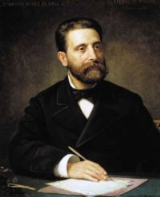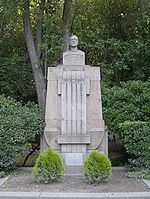
Gaspar Núñez de Arce
Encyclopedia
Gaspar Núñez de Arce was a Spanish
poet
, dramatist and statesman
.
He was born at Valladolid
, where he was educated for the priesthood. He had no vocation for the ecclesiastical state, plunged into literature, and produced a play entitled Amor y Orgullo which was acted at Toledo
in 1849. To the displeasure of his father, an official in the post office, the youth refused to enter the seminary, and escaped to Madrid
, where he obtained employment on the staff of El Observador
, a Liberal newspaper. He afterwards founded El Bachiller Honduras, a journal in which he advocated a policy of Liberal concentration, and he attracted sufficient notice to justify his appointment as governor of Logrono
, and his nomination as deputy for Valladolid in 1865.
He was imprisoned at Cáceres
for his violent attacks on the reactionary ministry of Narvaez
, acted as secretary to the revolutionary Junta of Catalonia when Isabella II was dethroned, and wrote the "Manifesto to the Nation" published by the provisional government on 26 October 1868. During the next few years he practically withdrew from political life till the restoration, when he attached himself to Sagasta's party. He served under Sagasta as minister for the colonies, the interior, the exchequer and education; but ill-health compelled him to resign on 27 July 1890, and henceforth he refused to take office again. He was elected to the Spanish Academy on the 8 January 1874 and was appointed a life-senator
in 1886. He died at Madrid in February 1903.
 Núñez de Arce first came into notice as a dramatist, and he remained faithful to the stage for nearly a quarter of a century. In addition to three plays written in collaboration with Antonio Hurtado, he produced ¿Quien es el autor? (1859), La Cuenla del Zapatero (1859), ¡Como se empeña un marido! (1860), Deudas de la honra (1863), Ni lanto ni tan poco (1865), Quien debe, paga (1867) and El haz de Una (1872).
Núñez de Arce first came into notice as a dramatist, and he remained faithful to the stage for nearly a quarter of a century. In addition to three plays written in collaboration with Antonio Hurtado, he produced ¿Quien es el autor? (1859), La Cuenla del Zapatero (1859), ¡Como se empeña un marido! (1860), Deudas de la honra (1863), Ni lanto ni tan poco (1865), Quien debe, paga (1867) and El haz de Una (1872).
But Núñez de Arce's talent was more lyrical than dramatic, and his celebrity dates from the appearance of Gritos del combate (1875), a collection of poems exhorting Spaniards to lay aside domestic quarrels and to save their country from anarchy, more dangerous than a foreign foe. He maintained his position (in popular esteem) as the only possible rival of Campoamor
by a series of philosophic, elegiac and symbolic poems: "Raimundo Lulio, Ultima Iamentacion de Lord Byron" (1879), "Un Idilio y una Elegia" (1879), "La Selva oscura" (1879) and "La Visidn de Fray Martin" (1880). The old brilliance sets off the naturalistic observation of La Pesca (1884) and La Maruja (1886). The list of his works is completed by Poemas cortos (1895) and ISursum cordal (1900); Herndn el lobo, published in El Liberal (January 23, 1881) and Luzbel remain unfinished. His strength lies in the graciousness of his vision, his sincerity and command of his instrument; his weakness derives from his divided sympathies, his moods of obvious sentiment and his rhetorical facility. But at his best, as in the Gritos del combate, he is a master of virile music and patriotic doctrine.
Spain
Spain , officially the Kingdom of Spain languages]] under the European Charter for Regional or Minority Languages. In each of these, Spain's official name is as follows:;;;;;;), is a country and member state of the European Union located in southwestern Europe on the Iberian Peninsula...
poet
Poet
A poet is a person who writes poetry. A poet's work can be literal, meaning that his work is derived from a specific event, or metaphorical, meaning that his work can take on many meanings and forms. Poets have existed since antiquity, in nearly all languages, and have produced works that vary...
, dramatist and statesman
Statesman
A statesman is usually a politician or other notable public figure who has had a long and respected career in politics or government at the national and international level. As a term of respect, it is usually left to supporters or commentators to use the term...
.
He was born at Valladolid
Valladolid
Valladolid is a historic city and municipality in north-central Spain, situated at the confluence of the Pisuerga and Esgueva rivers, and located within three wine-making regions: Ribera del Duero, Rueda and Cigales...
, where he was educated for the priesthood. He had no vocation for the ecclesiastical state, plunged into literature, and produced a play entitled Amor y Orgullo which was acted at Toledo
Toledo, Spain
Toledo's Alcázar became renowned in the 19th and 20th centuries as a military academy. At the outbreak of the Spanish Civil War in 1936 its garrison was famously besieged by Republican forces.-Economy:...
in 1849. To the displeasure of his father, an official in the post office, the youth refused to enter the seminary, and escaped to Madrid
Madrid
Madrid is the capital and largest city of Spain. The population of the city is roughly 3.3 million and the entire population of the Madrid metropolitan area is calculated to be 6.271 million. It is the third largest city in the European Union, after London and Berlin, and its metropolitan...
, where he obtained employment on the staff of El Observador
El Observador
El Observador is the Spanish language newscast of Radio Caracas Televisión . It is one of the first television news programs in Venezuela.-History:El Observador is one of the first television news programs in Venezuela...
, a Liberal newspaper. He afterwards founded El Bachiller Honduras, a journal in which he advocated a policy of Liberal concentration, and he attracted sufficient notice to justify his appointment as governor of Logrono
Logroño
Logroño is a city in northern Spain, on the Ebro River. It is the capital of the autonomous community of La Rioja, formerly known as La Rioja Province.The population of Logroño in 2008 was 153,736 and a metropolitan population of nearly 197,000 inhabitants...
, and his nomination as deputy for Valladolid in 1865.
He was imprisoned at Cáceres
Cáceres, Spain
Cáceres is the capital of the same name province, in the autonomous community of Extremadura, Spain. , its population was 91,131 inhabitants. The municipio has a land area of 1,750.33 km², and is the largest in geographical extension in Spain....
for his violent attacks on the reactionary ministry of Narvaez
Narvaez
Narvaez is a Basque surname, and may refer to:*Luis de Narváez, 16th-century Spanish composer*Pánfilo de Narváez, 16th-century Spanish conquistador and explorer*Francisco Miguel Narváez Machón, a.k.a...
, acted as secretary to the revolutionary Junta of Catalonia when Isabella II was dethroned, and wrote the "Manifesto to the Nation" published by the provisional government on 26 October 1868. During the next few years he practically withdrew from political life till the restoration, when he attached himself to Sagasta's party. He served under Sagasta as minister for the colonies, the interior, the exchequer and education; but ill-health compelled him to resign on 27 July 1890, and henceforth he refused to take office again. He was elected to the Spanish Academy on the 8 January 1874 and was appointed a life-senator
Senator for life
A senator for life is a member of the senate or equivalent upper chamber of a legislature who has life tenure. , 7 Italian Senators out of 322, 4 out of the 47 Burundian Senators and all members of the British House of Lords have lifetime tenure...
in 1886. He died at Madrid in February 1903.

But Núñez de Arce's talent was more lyrical than dramatic, and his celebrity dates from the appearance of Gritos del combate (1875), a collection of poems exhorting Spaniards to lay aside domestic quarrels and to save their country from anarchy, more dangerous than a foreign foe. He maintained his position (in popular esteem) as the only possible rival of Campoamor
Ramon de Campoamor y Campoosorio
Ramón María de las Mercedes de Campoamor y Campoosorio , known as Ramón de Campoamor, asturien realist poet and philosopher, was born at Navia on September 24, 1817....
by a series of philosophic, elegiac and symbolic poems: "Raimundo Lulio, Ultima Iamentacion de Lord Byron" (1879), "Un Idilio y una Elegia" (1879), "La Selva oscura" (1879) and "La Visidn de Fray Martin" (1880). The old brilliance sets off the naturalistic observation of La Pesca (1884) and La Maruja (1886). The list of his works is completed by Poemas cortos (1895) and ISursum cordal (1900); Herndn el lobo, published in El Liberal (January 23, 1881) and Luzbel remain unfinished. His strength lies in the graciousness of his vision, his sincerity and command of his instrument; his weakness derives from his divided sympathies, his moods of obvious sentiment and his rhetorical facility. But at his best, as in the Gritos del combate, he is a master of virile music and patriotic doctrine.

